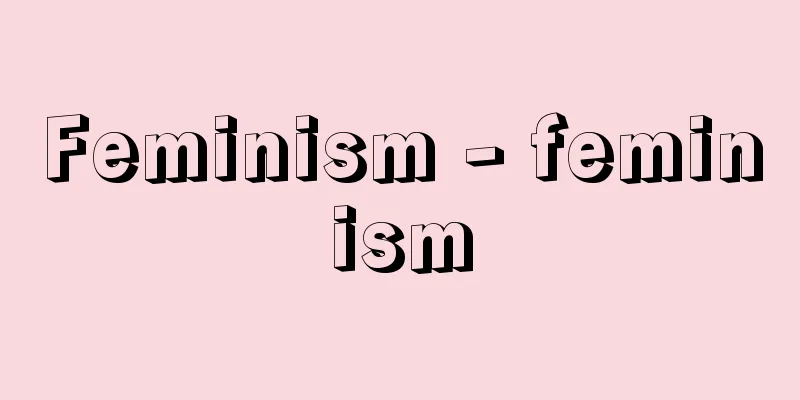Heredity - Iden (English spelling) heredity

|
Originally, it meant the phenomenon in which certain traits are passed down from parents to their children and from their children to their grandchildren. The reason why a dog's offspring remains a dog and a frog's offspring remains a frog, no matter how many generations pass, is because the basic blueprint of the traits specific to a species is passed down from parents to their children and from their children to their grandchildren, and the material that corresponds to this blueprint is called germplasm. Germplasm is a collection of genes, and its carriers are usually found in chromosomes in the cell nucleus, but can also be found in the cytoplasm. If we consider the phenomenon of heredity as a process of information transmission, it can include not only the relationship between parent and offspring generations (vertical relationship), but also the relationship between cells involved in cell division (horizontal relationship). A gene was originally a hypothetical unit of heredity, but advances in molecular genetics have made its true nature clear. A gene is a specific segment of DNA (deoxyribonucleic acid), and can be described as an information unit consisting of a chain of tens or hundreds of information elements (triplets) consisting of three bases. [Yataro Tajima] Heredity and environmentThe vast majority of higher organisms reproduce sexually. In this case, a reproductive cell from the female parent, i.e. an egg, combines with a reproductive cell from the male parent, i.e. a sperm, to produce a fertilized egg, which then undergoes cell division to multiply and form a new individual. The exact same genetic information contained in the fertilized egg is generated and passed on to the new cells. When a new individual is formed, its traits are determined by the genetic material passed on from both parents, but in this case it is influenced by many environmental factors (physical, chemical, and biological). For example, the fertilized egg of a bee or ant will grow into a queen or a worker bee or ant depending on the food it is raised on. The traits of an organism are determined by the interaction between genetics and the environment. Of course, some traits are strongly influenced by the environment, while others are relatively unaffected. The traits of an organism are influenced by the environment during the process of their manifestation, but the genetic material itself is immutable, and the environment cannot change the genetic material. Changes in trait expression caused by the environment only last for one generation. This is evident from the fact that children whose parents took thalidomide during pregnancy and developed atherosclerosis go on to give birth to completely normal children. [Yataro Tajima] The laws of inheritanceIn higher organisms, meiosis occurs in both males and females during the formation of reproductive cells, reducing the number of chromosomes by half. These chromosomes then combine to return to the original number through fertilization. In this way, the cycle of 2n→n→2n→n is repeated. Therefore, if the homologous chromosomes received from both parents are labeled with the A and a genes, then in the gamete formation of the F 1 (first generation hybrid) individual, the same number of A gametes and a gametes will be formed in both females and males, and through random combination of these, the offspring (F 2 ) will be expected to produce three types of individuals, AA, Aa, and aa, in a ratio of 1:2:1. In this case, if AA and Aa have the same A phenotype, the observed segregation ratio will be 3:1 ( ). The Austrian geneticist Mendel theoretically inferred this, performed experiments using pea plants, and statistically analyzed the results, proving the correctness of his inference in 1865. Since the mechanism deduced by Mendel applies to all higher organisms that reproduce sexually, it is named "Mendel's law" and forms the basic principle of genetic phenomena. [Yataro Tajima] Various inheritance patternsAll traits that Mendel studied showed a 3:1 segregation ratio in the F2 because both homozygotes (AA) and heterozygotes (Aa) expressed the dominant trait. However, there are cases where homozygotes and heterozygotes express the color differently. For example, in Mirabilis, homozygotes show red and heterozygotes show pink. In such cases, the segregation ratio in the F2 is 1:2:1. When two pairs of traits are crossed simultaneously, the typical segregation ratio is 9:3:3:1 ( ). However, when there is a special interaction between dominant genes for two different alleles, this ratio can be modified to 9:3:4, 9:7, 12:3:1, or 13:3. [Yataro Tajima] Attraction, reciprocity, and chain reactionIn crossing two pairs of allelic traits, it was found that two dominant genes from different parents always repel each other and no recombination occurs, and two dominant genes from the same parent always inherit together and no separation occurs between them. The former is called reciprocity, and the latter is called attraction. This corresponds to the cases where each allele is located on a different pair of homologous chromosomes, and where it is located on the same chromosome. From this, it was found that genes are located in a linked manner on chromosomes. This is called gene linkage. It was later found that recombination occurs between these genes at a certain rate. This is called chromosomal crossing over ( ). The further apart the loci where the two genes are located on the chromosome, the higher the rate of recombination. Therefore, by using this relationship in reverse, the relative positions of genes on the chromosome can be determined from the magnitude of the recombination value. A diagram showing the relative positions of gene loci is called a chromosome map. [Yataro Tajima] Sex-linked inheritanceWhen genes are located on sex chromosomes, there is a special relationship between gene segregation and sex. For example, in organisms with XY males, the trait controlled by the gene located on the Y chromosome is passed from the male to his offspring, but when a male with a dominant gene on the X chromosome is mated with a recessive female, the offspring will be male of the female parent type and female of the male parent type, a phenomenon known as cross-pattern inheritance ( ). [Yataro Tajima] Continuous mutationThe pea traits that Mendel chose for his experiment were clearly distinguishable traits such as round or wrinkled kernels, but biological traits are not limited to these. For example, there are traits such as human height and weight, or certain enzyme activities, which are expressed on a continuum from small to large, and it is unclear where to make the distinction. In such cases, many cooperating genes (synonymous genes) are often involved. In such cases, it is convenient to consider an ideal model in which all genes work equally in mathematical terms. In addition to being expressed by genes (genetic variation σG 2 ), quantitative traits are expressed by environmental conditions (environmental variation σE 2 ). The ratio of genetic variation to the total variation exhibited by an organism is called heritability h 2 , which can be calculated from the variance of statistics using the following formula: h2 = σG2 /( σG2 + σE2 + σGE2 ) (where h2 is between 0 and 1) [Yataro Tajima] Cytoplasmic inheritanceWhen the material that carries the genetic material exists outside of a chromosome, Mendel's laws of inheritance do not apply, and the plant often exhibits omnivorous inheritance. This includes cytoplasmic inheritance and infectious inheritance. A good example of cytoplasmic inheritance is the variegated Mirabilis. In this plant, a single plant can have all-green leaves, all-white leaves, or variegated leaves, which vary depending on the branch. If seeds are harvested by self-fertilization from flowers that bloom on all-green branches, the next generation will produce all-green plants, and the next generation from all-white branches will only produce all-white seedlings. Also, if flowers that bloom on variegated branches are self-fertilized, the next generation will produce variegated, all-green, and all-white plants. Similarly, the F1 cross between a variegated female and an all-green male will produce variegated, all-green, and all-white plants, but the reverse cross will only produce all-green plants. This phenomenon would be well explained if variegation were caused by mutated genes on the chloroplasts present in the cytoplasm. In this case, the chloroplasts are transmitted from the egg cell but not from the pollen. However, in the case of variegation in Pelargonium, the chloroplasts are also transmitted from the pollen. [Yataro Tajima] "Basic Genetics" by Yoshimasa Tanaka, corrected 35th edition (1982, Shokabo)" ▽ "Modern Biology Series 13: Cells and Genetics" edited by Norihiko Ono (1966, Nakayama Shoten)" ▽ "Nucleic Acids and Genetics" by Mutsuo Sekiguchi (1980, Baifukan)" [References] | | | |Example of peas: "P" Pure line parent (P) plants have two of the same gene. If the gene for reddish purple flowers is represented by C and the gene for white flowers by c, then the genes of P will be CC and cc. "F" The first generation hybrid (F) plants receive one gene each from P and have the genotype of Cc, but the traits of the C gene appear externally (law of dominance). "F" When the second generation hybrid (F) is obtained by self-fertilization of F, individuals with traits that appeared in F and individuals with traits that did not appear are produced in a ratio of 3:1 (law of segregation). ©Shogakukan "> Mendel's Law (in the case of homozygous hybrids) (Figure A... The F produced by crossing two pairs of opposing traits (here, yellow and green, round and wrinkled) is called a hermaphrodite hybrid. If the genes for yellow are Y, green for y, round for R, and wrinkles for r, then the genotypes of P (parents) will be YYRR and yyrr, respectively. The genotype of the first generation of F hybrid (F) will be YyRr, and the dominant trait of yellow round grains will appear. If F is self-fertilized, in the second generation of hybrid (F), the segregation of the YyRr alleles will occur independently of each other, resulting in four types of gametes in a ratio of YR:Yr:yR:yr = 1:1:1:1 (law of independent assortment). The ratio of those expressing the YR trait (YYRR, YYrR, YYRr, yYRR, YyRR, yYrR, yYRr, YyrR, YyRr), those expressing Yr (YYrr, yYrr, Yyrr), those expressing yR (yyRR, yyrR, yyRr), and those expressing yr (yyrr) is 9:3:3:1 . Mendel's Law (in the case of hermaphroditism) (Figure B... In addition to offspring with the same linked traits as P, as in ① and ②, new combinations of traits, as in ③ and ④, are produced. This is because recombination occurs between the originally linked genes, and the part with the normal body color gene is replaced by the part with the vestigial wing gene, and the part with the black body gene is replaced by the part with the normal wing gene. This is called crossing over . Gene linkage and crossover (Figure C) Inheritance of eye color in Drosophila. Sex-linked inheritance is carried out by genes on the X chromosome, and in this case, both the genes for red and white eyes are on the X chromosome. ©Shogakukan "> Sex-linked inheritance (Figure D) Source: Shogakukan Encyclopedia Nipponica About Encyclopedia Nipponica Information | Legend |
|
元来はある種の形質が、親から子、子から孫へ伝えられる現象をいう。イヌの子は何代たってもイヌ、カエルの子はカエルであるのは、種特有の形質の基本的設計図が、親から子、子から孫へと伝えられるからであって、この設計図にあたる物質を遺伝質という。遺伝質は遺伝子の集合体であって、その担い手は普通、細胞核内の染色体にあるが、細胞質に存在する場合もある。 遺伝の現象を情報伝達の過程としてとらえれば、これには親世代と子世代の間の関係(縦の関係)ばかりでなく、細胞分裂に伴う細胞と細胞との関係(横の関係)も含めることができる。遺伝子は、初め仮定上の遺伝単位であったが、分子遺伝学の進歩により、今日ではその実体が明らかになった。すなわちDNA(デオキシリボ核酸)の特定の区域であって、塩基3個からなる情報素子(トリプレット)が数十ないし数百個連鎖して構成される情報単位ということができる。 [田島弥太郎] 遺伝と環境高等生物のほとんど大部分は有性生殖を行う。この場合、雌親に由来する生殖細胞すなわち卵子と、雄親に由来する生殖細胞すなわち精子とが合体して受精卵が生じ、これが細胞分裂を行って増殖し、新しい個体を形成する。受精卵のもつ遺伝情報は、正確に同じものが生成されて新生細胞に伝えられていく。新個体形成にあたっては、両親から伝えられた遺伝質によって形質が規定されるが、この場合には多数の環境要因(物理的、化学的ならびに生物学的)の影響を受ける。たとえば、ハチやアリの受精卵が、育てられる餌(えさ)によって女王に育ったり、働きバチや働きアリに育つように、生物の形質は遺伝と環境との相互作用によって決まる。もちろん形質によってこの環境影響を強く受けるものと、比較的影響を受けにくいものとがある。生物の形質は、それが発現する過程で環境の影響を受けるが、遺伝質そのものは不変であって、環境は遺伝質まで変えることはできない。環境によって引き起こされた形質表現の変化は1代限りである。このことは、親が妊娠中にサリドマイドを服用したためにあざらし肢症(ししょう)となった患児が、親になって生む子がまったく正常であることをみれば明らかである。 [田島弥太郎] 遺伝の法則高等生物では、生殖細胞形成にあたり、雌でも雄でも減数分裂がおこって染色体数の半減がおこる。これが受精により合体して元の数に戻る。このようにして2n→n→2n→nのサイクルが繰り返される。したがって、両親から受け取る相同染色体のそれぞれを遺伝子Aとaで標識しておけば、F1(雑種第一代)個体の配偶子形成にあたり、雌でも雄でもA配偶子とa配偶子とが同数形成され、それらの機会的結合によって、その子(F2)の代にはAA、Aa、aaの3種類の個体が1:2:1の比に生じてくることが期待される。この場合AAとAaとが同じくA表現型をとるとすれば、観察される分離比は3:1である()。このことをオーストリアの遺伝学者メンデルは理論的に推察し、エンドウを用いて実験を行い、その結果を統計的に分析して、1865年に推論の正しいことを証明した。メンデルの推論した機構は、有性生殖を行う高等生物にはすべて当てはまるので、「メンデルの法則」と名づけられ、遺伝現象の基本原理となっている。 [田島弥太郎] さまざまな遺伝形式メンデルが研究の対象とした形質はすべてF2で3:1の分離を示したが、これは優性遺伝子に関しホモ型(AA)もヘテロ型(Aa)もともに優性形質を表現したためである。これに対しホモ型とヘテロ型とで表現を異にする場合がある。たとえば、オシロイバナではホモ型は赤、ヘテロ型はピンク色を示す。このような場合F2の分離は1:2:1となる。2対の形質を同時に実験の対象としてかけ合わせを行うと、典型的な場合9:3:3:1の比率で分離が行われる()。ただし、二つの異なった対立形質に関する優性遺伝子の間に特別な相互作用が働く場合には、この比が変形されて9:3:4とか9:7とか12:3:1とか13:3のような分離比がみられる。 [田島弥太郎] 相引・相反・連鎖2対の対立形質のかけ合わせで、別々の親からきた二つの優性遺伝子がつねに反発して組換えがおこらなかったり、同じ親からきた二つの優性遺伝子がつねに相伴って遺伝して、その間に分離のおこらない場合などがみいだされた。前者を相反(そうはん)、後者を相引(そういん)と名づける。これは、対立遺伝子のそれぞれが、相同染色体の異なった対の上に座位する場合と、同一染色体上に存在する場合とにあたる。このようなことから、遺伝子は染色体上に相連なって座位していることがわかった。これを遺伝子の連鎖(れんさ)という。その後、これらの遺伝子の間には一定の割合で組換えがおこることが知られた。これが染色体の乗換え(交叉(こうさ))である()。二つの遺伝子の存在する座位が染色体上で遠く離れているものほど、組換えのおこる率が高い。したがって、この関係を逆に利用すれば、組換え価の大きさから染色体上における遺伝子の相対的位置を定めることができる。遺伝子座位の相対位置を示す図を染色体地図という。 [田島弥太郎] 伴性遺伝遺伝子が性染色体上に存在する場合には、遺伝子の分離と性との間に特別な関係が認められる。たとえば、雄がXY型の生物では、Y染色体上に座位する遺伝子によって支配される形質は、雄親から雄の子へと伝えられるが、X染色体上にある優性遺伝子をもつ雄を劣性の雌と交配させると、生まれる子のうち雄は雌親型、雌は雄親型となり、いわゆる十文字遺伝がみられる()。 [田島弥太郎] 連続変異メンデルが実験に選んだエンドウの形質は、丸粒とか、しわ粒のように明確に区別できる形質であったが、生物の形質はこのようなものだけではない。たとえば、ヒトの身長や体重とか、ある種の酵素活性のように、その表現が小さいものから大きいものまで連続的で、どこで区別したらよいかわからないものがある。このような例では、多数の協力しあう遺伝子(同義遺伝子)が関係している場合が多い。このような場合、すべての遺伝子が等価に働くという理想的なモデルを考えると、数学的取扱いに便利である。数量的形質の表現は、遺伝子によるもの(遺伝変異σG2)のほかに、環境条件によってもたらされるもの(環境変異σE2)がある。生物の示す全変異に対する遺伝変異の割合を遺伝率h2というが、これは統計量の分散から次式で求めることができる。 h2=σG2/(σG2+σE2+σGE2) (ただしh2は0~1) [田島弥太郎] 細胞質遺伝遺伝質を担う物質が染色体外に存在する場合には、メンデルの遺伝法則は適用されず、偏母(へんぼ)性の遺伝を示す場合が多い。このなかには細胞質遺伝や感染性遺伝が含まれる。細胞質遺伝の好例は斑入(ふい)りオシロイバナの場合である。この植物では1本の株に全緑の葉、全白の葉、斑入りの葉があり、枝により異なる。全緑の枝に咲いた花から自家受精で採種すれば次代は全部全緑株、全白の枝からの次代は全白の苗しか生じない。また、斑入りの枝に咲いた花を自家受精すると、次代には斑入り株、全緑株、全白株が生ずる。また、斑入り雌×全緑雄のF1もこれと同様斑入り株、全緑株、全白株を生ずるが、その逆交雑では全緑のみである。 この現象は、斑入りが細胞質内に存在する葉緑体上の突然変異遺伝子に原因するとすれば、よく説明される。この例では、葉緑体は卵細胞からは伝わるが、花粉からは伝わらない。しかし、テンジクアオイの斑入りの場合は花粉からも葉緑体が持ち込まれるという。 [田島弥太郎] 『田中義磨著『基礎遺伝学』訂正35版(1982・裳華房)』▽『小野記彦編『現代生物学大系13 細胞・遺伝』(1966・中山書店)』▽『関口睦夫著『核酸と遺伝』(1980・培風館)』 [参照項目] | | | |エンドウの例「P」純系統の親(P)の植物は同じ遺伝子を2個もつ。赤紫花の遺伝子をC、白色花の遺伝子をcで表すとPの遺伝子はCC、ccとなる「F」雑種第一代(F)の植物はPから1個ずつの遺伝子が与えられ遺伝子型はCcとなるが、外見上はC遺伝子の形質が現れる(優性の法則)「F」Fの自家受精により雑種第二代(F)を得るとFで現れた形質の個体と現れなかった形質の個体が3:1の割合で生じる(分離の法則)©Shogakukan"> メンデルの法則(単性雑種の場合)〔図A… 「P」2組の対立する形質(ここでは黄色と緑色、丸と皺)を対象として交雑してできたFを両性雑種とよぶ。黄色をY、緑色をy、丸をR、皺をrという遺伝子とするとP(親)の遺伝子型はそれぞれYYRR、yyrrとなる「F」雑種第一代(F)の遺伝子型はYyRrとなり黄色丸粒の優性の形質が現れる「F」Fを自家受精させると雑種第二代(F)では、YyRrの対立遺伝子の分離は互いに独立に行われ、4種の配偶子をYR:Yr:yR:yr=1:1:1:1の比に生じる(独立の法則)。YRの形質を表に現すもの(YYRR、YYrR、YYRr、yYRR、YyRR、yYrR、yYRr、YyrR、YyRr)、Yrを表に現すもの(YYrr、yYrr、Yyrr)、yRを表に現すもの(yyRR、yyrR、yyRr)、yrを表に現すもの(yyrr)が9:3:3:1の割合となる©Shogakukan"> メンデルの法則(両性雑種の場合)〔図B… ①②のように、Pと同じ状態に連鎖した形質をもつ子孫のほか、③④のような新しい組合わせの形質が生じる。これは、本来連鎖していた遺伝子間に組換えがおこり、正常体色の遺伝子をもつ部分が、痕跡翅の遺伝子をもつ部分と、黒色体の遺伝子をもつ部分が正常翅の遺伝子をもつ部分とつなぎ換わったためで、これを乗換え(交叉)という©Shogakukan"> 遺伝子の連鎖と交叉〔図C〕 ショウジョウバエの眼色の遺伝。伴性遺伝はX染色体の遺伝子で行われ、この場合赤眼、白眼の遺伝子がともにX染色体にある©Shogakukan"> 伴性遺伝〔図D〕 出典 小学館 日本大百科全書(ニッポニカ)日本大百科全書(ニッポニカ)について 情報 | 凡例 |
<<: Sir Robert Anthony Eden, Earl of Avon
>>: Iden (English spelling) wei-tian; wei-t`ien
Recommend
Kirkuk - Kirkuk (English spelling)
A city in northeastern Iraq. Capital of At-Ta'...
Gustaf Gründgens
1899‐1963 West German actor and director. After wo...
double-hung
…The French window was developed in the 16th cent...
Food poisoning - Shokuchudoku (English spelling)
A disease caused by ingesting food or drink conta...
Hardenberg, FLFvon
…A representative poet and philosopher of the ear...
Udur - Udur
...Later, going a step further, it became customa...
Yellow Hachijo
A striped or checkered silk fabric with a yellow ...
cable television
…Abbreviation for cable television. Refers to a c...
Emperor Yongzheng
The fifth emperor of the Qing Dynasty of China (r...
Chernigov
The capital of Chernigov Oblast in northern Ukrai...
《De procuranda indorum salute》 (English notation) Deprocuranda indorum salute
…Compared to the histories of the Indies written ...
Hiratsuka Unichi - Hiratsuka Unichi
Printmaker. Born in Matsue, Shimane Prefecture. I...
Pulse amplitude modulation
…Part of APK is also called QAM (quadrature ampli...
Cantor set
...If it coincides with S , then S is said to be ...
Karukayainko (English spelling) grey-headed lovebird
A bird of the order Psittacidae in the class Aves...

![Mitsubishi Bank [Stock] - mitsubishiginko](/upload/images/67ccf2f5369dd.webp)







